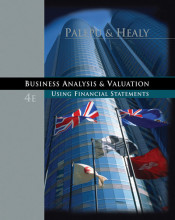Summary: Behavioral Corporate Finance. Decisions That Create Value. | 9780072848656 | Hersh Shefrin
- This + 400k other summaries
- A unique study and practice tool
- Never study anything twice again
- Get the grades you hope for
- 100% sure, 100% understanding
Read the summary and the most important questions on Behavioral Corporate Finance. Decisions that Create Value. | 9780072848656 | Hersh Shefrin
-
2 Taak 6 - Valuation
This is a preview. There are 8 more flashcards available for chapter 2
Show more cards here -
Valuation through growth opportunities involves decomposing equity value into two components:
- The value of the firm when it pays out 100 percent of its earnings as cash dividends
- The net present value associated with plowing back a portion of future earnings into the firm's future projects.
-
P/E Heuristics
An approach to valuation based on multiplying a P/E ratio and an earnings forecast. -
Price-to-sales heuristic
An approach to valuation based on multiplying a price-to-sales ratio and a sales forecast. -
Why do financial executives more rely on heuristics versus textbook techniques?
Heuristics are simpler to use (P/E, PEG, price-to-sales), they require few variables and involve simple formulas. The DCF-based analyses require far more detail than the heuristic techniques, involve more complex formulas and are less intuitive. -
6 Taak 4 - Capital Structure - Hersh Shefrin Behavioral Corporate Finance
This is a preview. There are 19 more flashcards available for chapter 6
Show more cards here -
What is book-to-market ratio
The book-to-market ratio attempts to identify undervalued or overvalued securities by taking the book value and dividing it by market value. In basic terms, if the ratio is above 1 then the stock is undervalued; if it is less than 1, the stock is overvalued.A ratio used to find the value of a company by comparing the book value of a firm to its market value. Book value is calculated by looking at the firm's historical cost, or accounting value. Market value is determined in the stock market through its market capitalization.
Formula: -
There are two main approaches to capital structure:
- Tradeoff Theory
- Pecking-order Theory
-
When do firms tend to issue new equity?
Firms tend to issue new equity, and therefore achieve lower debt-to-equity ratios, when their market-to-book ratios are high. This finding suggests that managers issue equity when that equity is most likely to be overvalued. Some researchers have concluded that issuing equity when the market-to-book ratio is high is on short-run phenomenon, meaning that fluctuations in market value can have very long-run impacts on capital structure. -
Convertible debt is an inexpensive way to issue "delayed" common stock. Why is this?
They issue convertible debt when stock is undervalued.- the interest rate on convertible debt tends to be less than the interest rate on fixed debt, so convertible debt appears to be a cheap form of debt financing.
- Convertible debt converts to equity only when the future stock price rises, it appears to be a cheap form of equity as well.
-
What factors affect how to choose the appropriate amount of debt for your firm?
- Maintaining a target debt-to-equity ratio
- Credit rating (as assigned by rating agencies)
- Tax advantage of interest deductibility
-
When are CFO's reluctant to issue equity?
When stocks are undervalued.
- Higher grades + faster learning
- Never study anything twice
- 100% sure, 100% understanding































